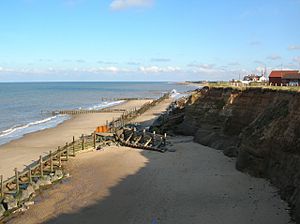Happisburgh Cliffs facts for kids
| Site of Special Scientific Interest | |
 |
|
| Area of Search | Norfolk |
|---|---|
| Interest | Geological |
| Area | 6.1 hectares (15 acres) |
| Notification | 1985 |
| Location map | Magic Map |
Happisburgh Cliffs is a special place in Norfolk, England. It's known for its amazing geology. These cliffs are a Site of Special Scientific Interest (SSSI). This means they are protected because they are important for science.
The cliffs cover about 6.1 hectares, which is like 15 football fields. They are located west of a town called North Walsham. Scientists study these cliffs to learn about Earth's past.
Contents
What Makes Happisburgh Cliffs Special?
Happisburgh Cliffs are truly unique. They show us layers of rock and soil left behind by ancient ice ages. These layers are called glacial deposits. It's like looking at a history book written in the ground!
A Window into the Ice Ages
The cliffs display three different layers from very old ice ages. The oldest layer is from about 1.9 million years ago. This time is called the Pre-Pastonian Stage. Imagine how long ago that was!
Another layer comes from the Beestonian period. The newest layers are called the Cromer Tills. These were formed during the Anglian stage, about 450,000 years ago. The Anglian stage was the coldest ice age of the Pleistocene era. During this time, huge sheets of ice covered much of the land.
Scientists can learn a lot by studying these layers. They help us understand how the Earth's climate has changed over millions of years. It's like finding clues about giant glaciers that once covered this area.
What is a Site of Special Scientific Interest (SSSI)?
A Site of Special Scientific Interest, or SSSI, is a protected area in the United Kingdom. These places are chosen because they have important wildlife, plants, or geological features. Happisburgh Cliffs is protected because of its amazing geological history.
It is also a Geological Conservation Review site. This means it's one of the best examples of geological features in Great Britain. Protecting these sites helps scientists and future generations study our planet's past.
Exploring the Cliffs Today
Today, the cliffs stand above a public beach. People can visit and enjoy the beautiful scenery. It's a great place to see how nature has shaped our world over millions of years. Remember to always be careful near cliffs and respect the natural environment.

